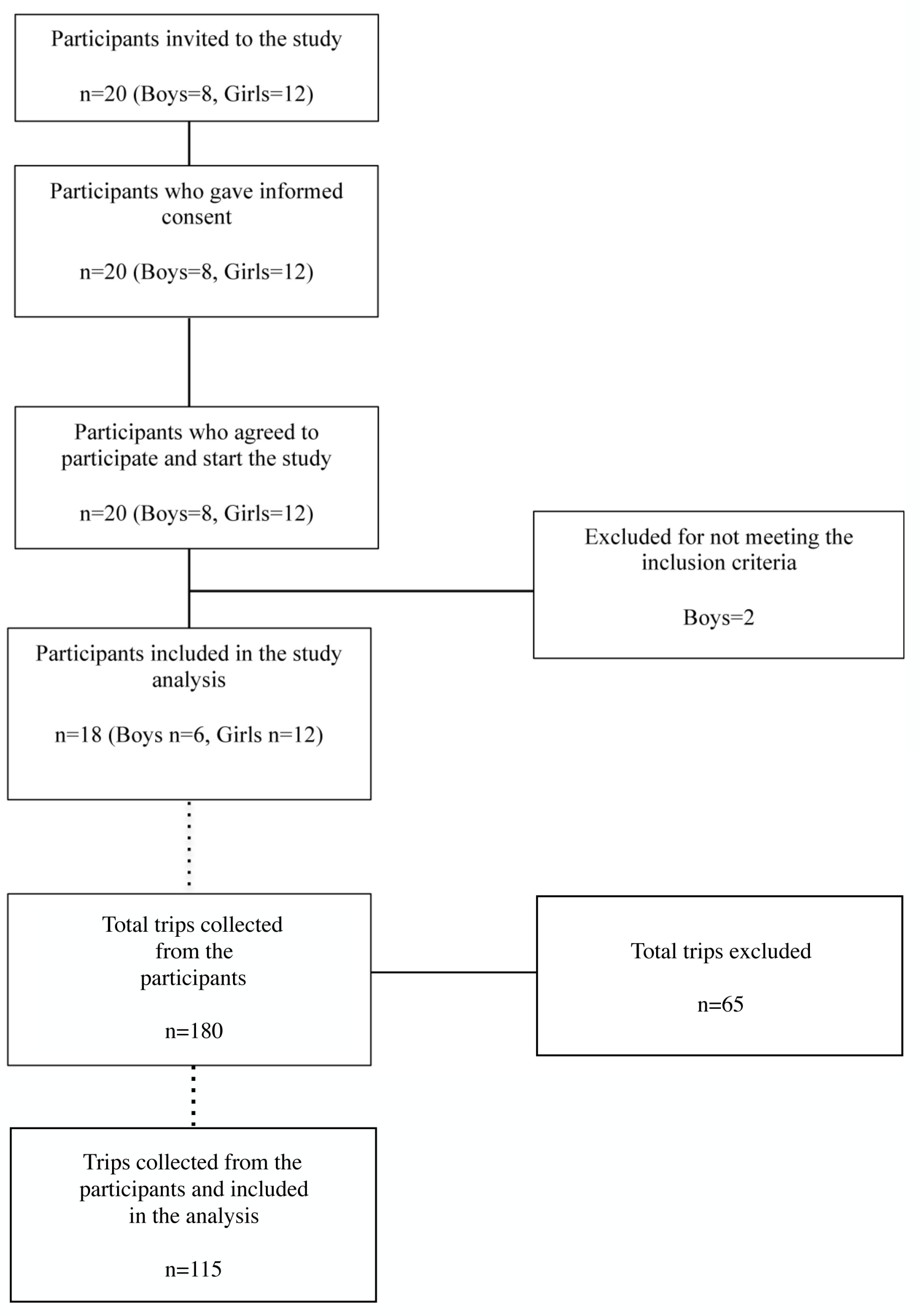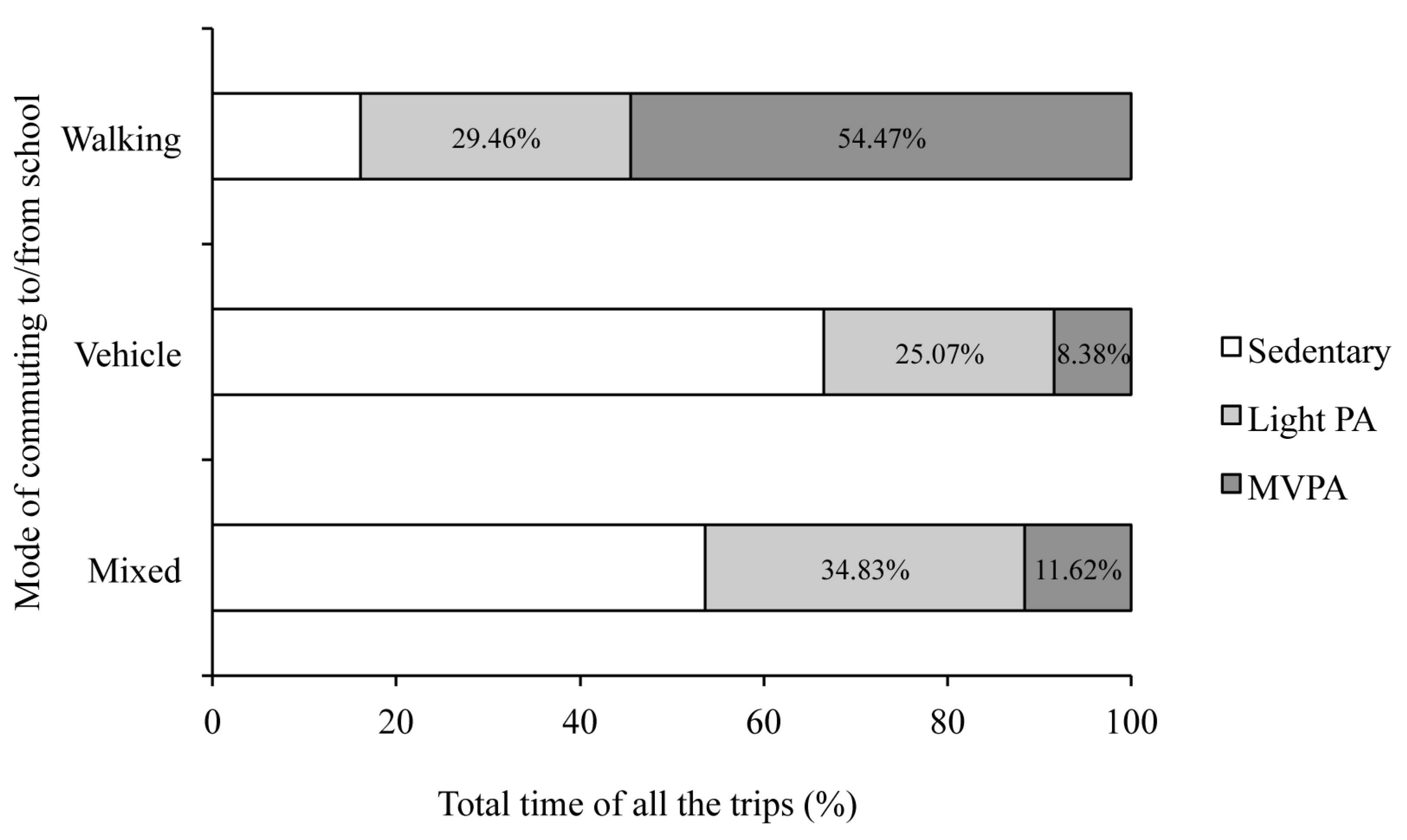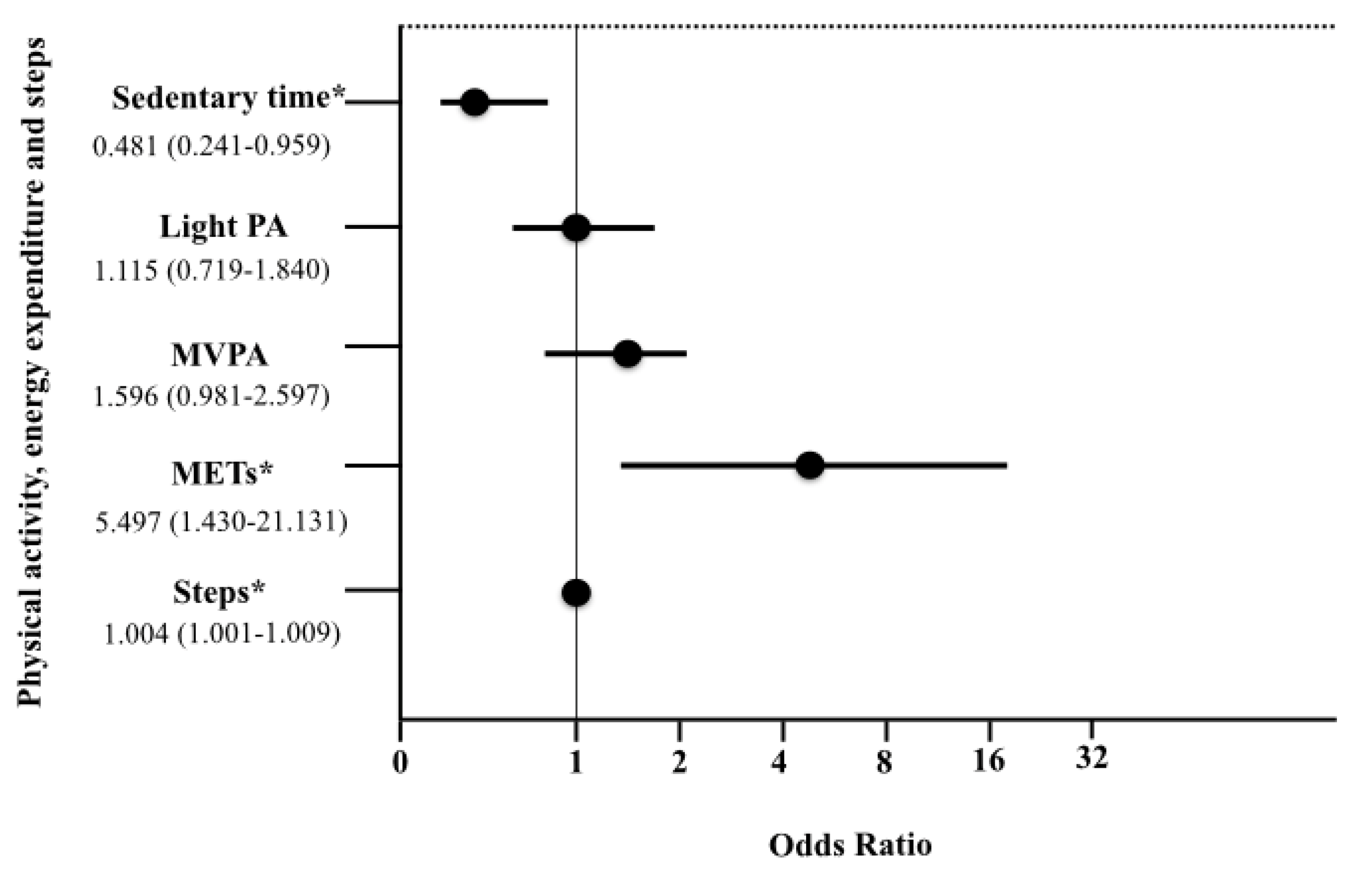Objective Measurement of the Mode of Commuting to School Using GPS: A Pilot Study
Abstract
1. Introduction
2. Participants and Methods
2.1. Study Design
2.1.1. Trips to and from School
2.1.2. Study Design and Procedure
2.2. Measurements
2.2.1. Positional Data and Mode of Commuting during the Trips to and from School
2.2.2. Activity Diary
2.2.3. Sedentary Time and PA
2.2.4. Anthropometric Characteristics
2.3. Statistical Analyses
3. Results
4. Discussion
5. Conclusions
Author Contributions
Funding
Acknowledgments
Conflicts of Interest
Appendix A

References
- WHO. Global Recommendations on Physical Activity for Health; World Health Organ Publications: Geneva, Switzerland, 2010. [Google Scholar]
- Dumith, S.C.; Gigante, D.P.; Domingues, M.R.; Kohl, H.W. Physical activity change during adolescence: A systematic review and a pooled analysis. Int. J. Epidemiol. 2011, 40, 685–698. [Google Scholar] [CrossRef] [PubMed]
- Ekelund, U.; Tomkinson, G.; Armstrong, N. What proportion of youth are physically active? Measurement issues, levels and recent time trends. Br. J. Sports Med. 2011, 45, 859–865. [Google Scholar] [CrossRef] [PubMed]
- Crawford, S.; Garrard, J. A combined impact-process evaluation of a program promoting active transport to school: Understanding the factors that shaped program effectiveness. J. Environ. Public Health 2013, 2013, 816961. [Google Scholar] [CrossRef] [PubMed]
- McDonald, N.C.; Steiner, R.L.; Lee, C.; Smith, T.R.; Zhu, X.M.; Yang, Y.Z. Impact of the safe routes to school program on walking and bicycling. J. Am. Plan. Assoc. 2014, 80, 153–167. [Google Scholar] [CrossRef]
- Klinker, C.D.; Schipperijn, J.; Toftager, M.; Kerr, J.; Troelsen, J. When cities move children: Development of a new methodology to assess context-specific physical activity behaviour among children and adolescents using accelerometers and gps. Health Place 2015, 31, 90–99. [Google Scholar] [CrossRef] [PubMed]
- Larouche, R.; Saunders, T.J.; Faulkner, G.; Colley, R.; Tremblay, M. Associations between active school transport and physical activity, body composition; cardiovascular fitness: A systematic review of 68 studies. J. Phys. Act. Health 2014, 11, 206–227. [Google Scholar] [CrossRef] [PubMed]
- Duncan, M.J.; Mummery, W.K. Gis or gps? A comparison of two methods for assessing route taken during active transport. Am. J. Prev. Med. 2007, 33, 51–53. [Google Scholar] [CrossRef] [PubMed]
- Sirard, J.R.; Slater, M.E. Walking and bicycling to school: A review. Am. J. Lifestyle Med. 2008, 2, 372–396. [Google Scholar] [CrossRef]
- Pizarro, A.N.; Schipperijn, J.; Andersen, H.B.; Ribeiro, J.C.; Mota, J.; Santos, M.P. Active commuting to school in portuguese adolescents: Using palms to detect trips. J. Transport. Health 2016, 3, 297–304. [Google Scholar] [CrossRef]
- Cooper, A.R.; Andersen, L.B.; Wedderkopp, N.; Page, A.S.; Froberg, K. Physical activity levels of children who walk, cycle, or are driven to school. Am. J. Prev. Med. 2005, 29, 179–184. [Google Scholar] [CrossRef]
- Slingerland, M.; Borghouts, L.B.; Hesselink, M.K. Physical activity energy expenditure in dutch adolescents: Contribution of active transport to school, physical education, and leisure time activities. J. Sch. Health 2012, 82, 225–232. [Google Scholar] [CrossRef] [PubMed]
- Hohepa, M.; Schofield, G.; Kolt, G.S.; Scragg, R.; Garrett, N. Pedometer-determined physical activity levels of adolescents: Differences by age, sex, time of week, and transportation mode to school. J. Phys. Act. Health 2008, 5 (Suppl. 1), S140–S152. [Google Scholar] [CrossRef] [PubMed]
- Shephard, R.J. Is active commuting the answer to population health? Sports Med. 2008, 38, 751–758. [Google Scholar] [CrossRef] [PubMed]
- Perez, L.G.; Carlson, J.; Slymen, D.J.; Patrick, K.; Kerr, J.; Godbole, S.; Elder, J.P.; Ayala, G.X.; Arredondo, E.M. Does the social environment moderate associations of the built environment with latinas’ objectively-measured neighborhood outdoor physical activity? Prev. Med. Rep. 2016, 4, 551–557. [Google Scholar] [CrossRef] [PubMed]
- Torres-Luque, G.; Fernandez, I.; Santos-Lozano, A. Actividad física y acelerometría; orientaciones metodológicas, recomendaciones y patrones. Nutr. Hosp. 2014, 31, 115–128. [Google Scholar]
- Schipperijn, J.; Kerr, J.; Duncan, S.; Madsen, T.; Klinker, C.D.; Troelsen, J. Dynamic accuracy of gps receivers for use in health research: A novel method to assess gps accuracy in real-world settings. Front. Public Health 2014, 2, 21. [Google Scholar] [CrossRef] [PubMed]
- Carlson, J.A.; Jankowska, M.M.; Meseck, K.; Godbole, S.; Natarajan, L.; Raab, F.; Demchak, B.; Patrick, K.; Kerr, J. Validity of palms gps scoring of active and passive travel compared with sensecam. Med. Sci. Sports Exerc. 2015, 47, 662–667. [Google Scholar] [CrossRef] [PubMed]
- Wang, Y.; Zou, Y.; Henrickson, K.; Wang, Y.; Tang, J.; Park, B.J. Google earth elevation data extraction and accuracy assessment for transportation applications. PLoS ONE 2017, 12, e0175756. [Google Scholar] [CrossRef]
- Migueles, J.H.; Cadenas-Sanchez, C.; Ekelund, U.; Delisle Nystrom, C.; Mora-Gonzalez, J.; Lof, M.; Labayen, I.; Ruiz, J.R.; Ortega, F.B. Accelerometer data collection and processing criteria to assess physical activity and other outcomes: A systematic review and practical considerations. Sports Med. 2017, 47, 1821–1845. [Google Scholar] [CrossRef]
- Troiano, R.P. Large-scale applications of accelerometers: New frontiers and new questions. Med. Sci. Sports Exerc. 2007, 39, 1501. [Google Scholar] [CrossRef]
- Hanggi, J.M.; Phillips, L.R.; Rowlands, A.V. Validation of the gt3x actigraph in children and comparison with the gt1m actigraph. J. Sci. Med. Sport 2013, 16, 40–44. [Google Scholar] [CrossRef]
- Freedson, P.; Pober, D.; Janz, K.F. Calibration of accelerometer output for children. Med. Sci. Sports Exerc. 2005, 37, S523–S530. [Google Scholar] [CrossRef]
- Coelho, J.S.; Pullmer, R.; Robertson, M.; Marshall, S.; Lam, P.Y. Attitudes toward anthropometric measurements in youth: The role of eating pathology. Can. J. Behav. Sci. -Rev. Can. Sci. Comport. 2016, 48, 232–237. [Google Scholar] [CrossRef]
- Chillon, P.; Martinez-Gomez, D.; Ortega, F.B.; Perez-Lopez, I.J.; Diaz, L.E.; Veses, A.M.; Veiga, O.L.; Marcos, A.; Delgado-Fernandez, M. Six-year trend in active commuting to school in spanish adolescents. The avena and afinos studies. Int. J. Behav. Med. 2013, 20, 529–537. [Google Scholar] [CrossRef] [PubMed]
- Herrador-Colmenero, M.; Villa-Gonzalez, E.; Chillon, P. Children who commute to school unaccompanied have greater autonomy and perceptions of safety. Acta Paediatr. 2017, 106, 2042–2047. [Google Scholar] [CrossRef] [PubMed]
- Villa-Gonzalez, E.; Ruiz, J.R.; Ward, D.S.; Chillon, P. Effectiveness of an active commuting school-based intervention at 6-month follow-up. Eur. J. Public Health 2016, 26, 272–276. [Google Scholar] [CrossRef] [PubMed]
- Villa-Gonzalez, E.; Ruiz, J.R.; Mendoza, J.A.; Chillon, P. Effects of a school-based intervention on active commuting to school and health-related fitness. BMC Public Health 2017, 17, 20. [Google Scholar] [CrossRef]
- Mandic, S.; de la Barra, S.L.; Bengoechea, E.G.; Stevens, E.; Flaherty, C.; Moore, A.; Middlemiss, M.; Williams, J.; Skidmore, P. Personal, social and environmental correlates of active transport to school among adolescents in otago, new zealand. J. Sci. Med. Sport 2015, 18, 432–437. [Google Scholar] [CrossRef] [PubMed]
- Aires, L.; Pratt, M.; Lobelo, F.; Santos, R.M.; Santos, M.P.; Mota, J. Associations of cardiorespiratory fitness in children and adolescents with physical activity, active commuting to school; screen time. J. Phys. Act. Health 2011, 8, S198–S205. [Google Scholar] [CrossRef]
- Vermorel, M.; Vernat, J.; Bitar, A.; Fellmann, N.; Coudert, J. Daily energy expenditure, activity patterns, and energy costs of the various activities in french 12-16-y-old adolescents in free living conditions. Eur. J. Clin. Nutr. 2002, 56, 819–829. [Google Scholar] [CrossRef][Green Version]
- Ekelund, U.; Sjostrom, M.; Yngve, A.; Nilsson, A. Total daily energy expenditure and pattern of physical activity measured by minute-by-minute heart rate monitoring in 14-15 year old swedish adolescents. Eur. J. Clin. Nutr. 2000, 54, 195–202. [Google Scholar] [CrossRef] [PubMed]
- Corder, K.; Ekelund, U.; Steele, R.M.; Wareham, N.J.; Brage, S. Assessment of physical activity in youth. J. Appl. Physiol. 2008, 105, 977–987. [Google Scholar] [CrossRef]
- Tudor-Locke, C.; Craig, C.L.; Beets, M.W.; Belton, S.; Cardon, G.M.; Duncan, S.; Hatano, Y.; Lubans, D.R.; Olds, T.S.; Raustorp, A.; et al. How many steps/day are enough? For children and adolescents. Int. J. Behav. Nutr. Phys. Act. 2011, 8, 78. [Google Scholar] [CrossRef]
- Villa-González, E.; Barranco-Ruiz, Y.; Evenson, K.R.; Chillón, P. Systematic review of interventions for promoting active school transport. Prev. Med. 2018, 111, 115–134. [Google Scholar] [CrossRef] [PubMed]
- Southward, E.F.; Page, A.S.; Wheeler, B.W.; Cooper, A.R. Contribution of the school journey to daily physical activity in children aged 11-12 years. Am. J. Prev. Med. 2012, 43, 201–204. [Google Scholar] [CrossRef]
- Voss, C.; Winters, M.; Frazer, A.; McKay, H. School-travel by public transit: Rethinking active transportation. Prev. Med. Rep. 2015, 2, 65–70. [Google Scholar] [CrossRef] [PubMed]
- Kerr, J.; Duncan, S.; Schipperijn, J. Using global positioning systems in health research: A practical approach to data collection and processing. Am. J. Prev. Med. 2011, 41, 532–540. [Google Scholar] [CrossRef]



| Modes of Commuting (n = 115 Trips) | ||||
|---|---|---|---|---|
| Trips Characteristics | All | Walking | Vehicle | Mixed |
| Participants * | ||||
| Boys (n = 6, 33.3%) | 42 (35.2) | 22 (52.4) | 16 (38.1) | 4 (9.5) |
| Girls (n = 12, 66.7%) | 73 (64.8) | 35 (48.0) | 29 (39.7) | 9 (12.3) |
| Physical characteristics# | (n = 115) | (n = 57) | (n = 45) | (n = 13) |
| Total distance (Km) | 3.1 (5.6) | 1.3 (0.61) | 3.1 (4.9) | 11.6 (10.6) b,c |
| Total time (min) | 16.8 (15.16) | 19.7 (9.8) | 7.6 (5.6) | 35.6 (29.8) a,b,c |
| Elevation increase (m) | 32.2 (51.3) | 16.2 (12.9) | 32.7 (43.9) | 101.3(103.8) b,c |
| Elevation loss (m) | 34.8 (51.3) | 21.7 (11.4) | 31.4 (54.4) | 104.6 (96.4) b,c |
| PA during transport to school (total min)# | (n = 86) | (n = 47) | (n = 35) | (n = 4) |
| Sedentary (min) | 4.3 (5.0) | 3.1 (2.8) | 5.2 (6.3) | 10.6 (6.6) b |
| Light PA (min) | 4.2 (4.1) | 5.9 (4.6) a | 1.8 (1.6) | 6.2 (2.0) |
| MVPA (min) | 6.6 (7.1) | 11.4 (6.4) a,b | 0.8 (2.1) | 1.9 (1.0) |
| Energy expenditure# | (n = 86) | (n = 47) | (n = 35) | (n = 4) |
| METs/min | 2.5 (1.2) | 3.4 (0.7) a,b | 1.4 (0.6) | 1.7 (0.1) |
| Steps# | (n = 86) | (n = 47) | (n = 35) | (n = 4) |
| Total Steps (nº) | 992.0 (1008.4) | 1681.3 (858.3) a,b | 117.8 (268.8) | 540.2 (258.5) |
© 2019 by the authors. Licensee MDPI, Basel, Switzerland. This article is an open access article distributed under the terms and conditions of the Creative Commons Attribution (CC BY) license (http://creativecommons.org/licenses/by/4.0/).
Share and Cite
Villa-González, E.; Rosado-López, S.; Barranco-Ruiz, Y.; Herrador-Colmenero, M.; Cadenas-Sánchez, C.; Santos, M.P.; Chillón, P. Objective Measurement of the Mode of Commuting to School Using GPS: A Pilot Study. Sustainability 2019, 11, 5395. https://doi.org/10.3390/su11195395
Villa-González E, Rosado-López S, Barranco-Ruiz Y, Herrador-Colmenero M, Cadenas-Sánchez C, Santos MP, Chillón P. Objective Measurement of the Mode of Commuting to School Using GPS: A Pilot Study. Sustainability. 2019; 11(19):5395. https://doi.org/10.3390/su11195395
Chicago/Turabian StyleVilla-González, Emilio, Sergio Rosado-López, Yaira Barranco-Ruiz, Manuel Herrador-Colmenero, Cristina Cadenas-Sánchez, Maria Paula Santos, and Palma Chillón. 2019. "Objective Measurement of the Mode of Commuting to School Using GPS: A Pilot Study" Sustainability 11, no. 19: 5395. https://doi.org/10.3390/su11195395
APA StyleVilla-González, E., Rosado-López, S., Barranco-Ruiz, Y., Herrador-Colmenero, M., Cadenas-Sánchez, C., Santos, M. P., & Chillón, P. (2019). Objective Measurement of the Mode of Commuting to School Using GPS: A Pilot Study. Sustainability, 11(19), 5395. https://doi.org/10.3390/su11195395









